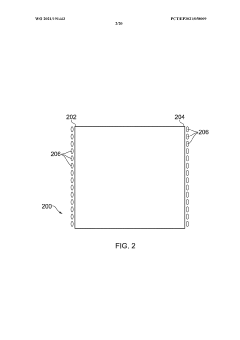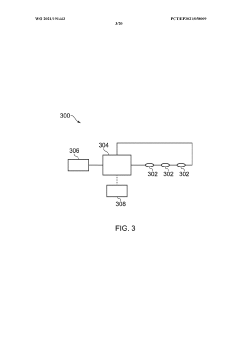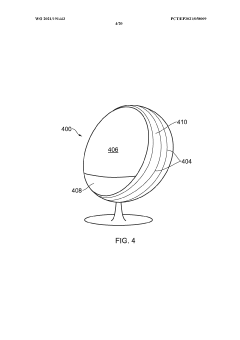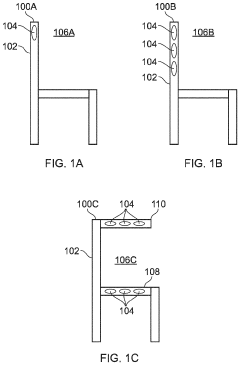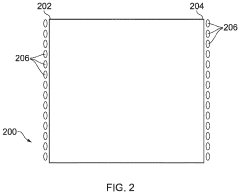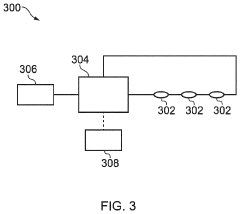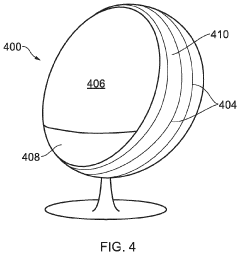How to Enhance Scientific Understanding of Schumann Resonance?
JUN 24, 20259 MIN READ
Generate Your Research Report Instantly with AI Agent
Patsnap Eureka helps you evaluate technical feasibility & market potential.
Schumann Resonance Background and Research Objectives
The Schumann resonance, discovered by physicist Winfried Otto Schumann in 1952, is a set of spectrum peaks in the extremely low frequency (ELF) portion of the Earth's electromagnetic field spectrum. These resonances occur between the Earth's surface and the ionosphere, creating a global electromagnetic resonance phenomenon. The primary frequency of this resonance is approximately 7.83 Hz, with harmonics at higher frequencies.
Over the past seven decades, research into Schumann resonances has evolved significantly, encompassing various scientific disciplines such as atmospheric physics, geophysics, and space weather studies. The study of these resonances has provided valuable insights into the Earth's electromagnetic environment and its interactions with solar activity and other geophysical phenomena.
The current technological landscape has enabled more precise measurements and analysis of Schumann resonances, leading to a deeper understanding of their characteristics and potential applications. Advanced sensors, data processing techniques, and global monitoring networks have contributed to the expansion of this field of study.
The primary objective of enhancing scientific understanding of Schumann resonances is to unlock their full potential as a tool for monitoring and predicting various Earth system processes. This includes investigating their relationship with global lightning activity, ionospheric dynamics, and potential correlations with climate change and extreme weather events.
Furthermore, researchers aim to explore the possible biological implications of Schumann resonances, particularly their influence on human health and cognitive functions. This avenue of research could potentially lead to novel applications in fields such as bioelectromagnetics and chronobiology.
Another key research goal is to improve the accuracy and reliability of Schumann resonance measurements, addressing challenges such as anthropogenic noise interference and geomagnetic field variations. This involves developing more sophisticated detection and analysis methods, as well as establishing a more comprehensive global monitoring network.
By advancing our understanding of Schumann resonances, scientists hope to gain new insights into the Earth's electromagnetic environment, its interactions with space weather, and its potential role in various geophysical and biological processes. This enhanced knowledge could have far-reaching implications for fields ranging from atmospheric science to telecommunications and human health research.
Over the past seven decades, research into Schumann resonances has evolved significantly, encompassing various scientific disciplines such as atmospheric physics, geophysics, and space weather studies. The study of these resonances has provided valuable insights into the Earth's electromagnetic environment and its interactions with solar activity and other geophysical phenomena.
The current technological landscape has enabled more precise measurements and analysis of Schumann resonances, leading to a deeper understanding of their characteristics and potential applications. Advanced sensors, data processing techniques, and global monitoring networks have contributed to the expansion of this field of study.
The primary objective of enhancing scientific understanding of Schumann resonances is to unlock their full potential as a tool for monitoring and predicting various Earth system processes. This includes investigating their relationship with global lightning activity, ionospheric dynamics, and potential correlations with climate change and extreme weather events.
Furthermore, researchers aim to explore the possible biological implications of Schumann resonances, particularly their influence on human health and cognitive functions. This avenue of research could potentially lead to novel applications in fields such as bioelectromagnetics and chronobiology.
Another key research goal is to improve the accuracy and reliability of Schumann resonance measurements, addressing challenges such as anthropogenic noise interference and geomagnetic field variations. This involves developing more sophisticated detection and analysis methods, as well as establishing a more comprehensive global monitoring network.
By advancing our understanding of Schumann resonances, scientists hope to gain new insights into the Earth's electromagnetic environment, its interactions with space weather, and its potential role in various geophysical and biological processes. This enhanced knowledge could have far-reaching implications for fields ranging from atmospheric science to telecommunications and human health research.
Global Interest in Earth's Electromagnetic Field Studies
The global interest in Earth's electromagnetic field studies has been steadily growing over the past few decades, driven by advancements in technology and an increasing awareness of the importance of understanding our planet's electromagnetic environment. This field of research encompasses a wide range of phenomena, including the Schumann resonance, which has become a focal point for scientists and researchers worldwide.
The scientific community's attention to Earth's electromagnetic field has been fueled by its potential implications for various disciplines, including atmospheric science, geophysics, and even human health. Researchers from diverse backgrounds are collaborating to unravel the complexities of these electromagnetic phenomena, recognizing their significance in understanding global climate patterns, ionospheric dynamics, and the Earth-Sun relationship.
In recent years, there has been a notable surge in international research initiatives focused on Earth's electromagnetic field. Major scientific institutions and universities across the globe have established dedicated research centers and programs to study these phenomena. For instance, the European Space Agency's Swarm mission, launched in 2013, has been providing unprecedented insights into Earth's magnetic field and its variations.
The advent of advanced sensing technologies and data processing capabilities has revolutionized the field, enabling more accurate and comprehensive measurements of Earth's electromagnetic environment. Satellite-based observations, ground-based monitoring networks, and sophisticated computer models have significantly enhanced our ability to detect and analyze subtle changes in the planet's electromagnetic field.
The Schumann resonance, in particular, has garnered increased attention due to its potential as a global indicator of atmospheric and ionospheric conditions. Scientists are exploring its applications in areas such as lightning detection, space weather forecasting, and even as a possible biomarker for planetary habitability. This has led to a growing number of research papers, conferences, and international collaborations focused on understanding and utilizing the Schumann resonance.
Furthermore, the interdisciplinary nature of Earth's electromagnetic field studies has attracted researchers from fields such as telecommunications, aerospace engineering, and environmental science. This diverse interest has resulted in novel applications and research directions, including the development of new communication technologies, improved navigation systems, and innovative approaches to monitoring global environmental changes.
As global interest continues to grow, funding for Earth's electromagnetic field studies has also increased. Government agencies, private foundations, and international organizations are recognizing the importance of this research and allocating resources to support long-term monitoring programs and cutting-edge research projects. This financial support is crucial for maintaining and expanding the global network of observatories and for developing next-generation instruments to study these phenomena with greater precision.
The scientific community's attention to Earth's electromagnetic field has been fueled by its potential implications for various disciplines, including atmospheric science, geophysics, and even human health. Researchers from diverse backgrounds are collaborating to unravel the complexities of these electromagnetic phenomena, recognizing their significance in understanding global climate patterns, ionospheric dynamics, and the Earth-Sun relationship.
In recent years, there has been a notable surge in international research initiatives focused on Earth's electromagnetic field. Major scientific institutions and universities across the globe have established dedicated research centers and programs to study these phenomena. For instance, the European Space Agency's Swarm mission, launched in 2013, has been providing unprecedented insights into Earth's magnetic field and its variations.
The advent of advanced sensing technologies and data processing capabilities has revolutionized the field, enabling more accurate and comprehensive measurements of Earth's electromagnetic environment. Satellite-based observations, ground-based monitoring networks, and sophisticated computer models have significantly enhanced our ability to detect and analyze subtle changes in the planet's electromagnetic field.
The Schumann resonance, in particular, has garnered increased attention due to its potential as a global indicator of atmospheric and ionospheric conditions. Scientists are exploring its applications in areas such as lightning detection, space weather forecasting, and even as a possible biomarker for planetary habitability. This has led to a growing number of research papers, conferences, and international collaborations focused on understanding and utilizing the Schumann resonance.
Furthermore, the interdisciplinary nature of Earth's electromagnetic field studies has attracted researchers from fields such as telecommunications, aerospace engineering, and environmental science. This diverse interest has resulted in novel applications and research directions, including the development of new communication technologies, improved navigation systems, and innovative approaches to monitoring global environmental changes.
As global interest continues to grow, funding for Earth's electromagnetic field studies has also increased. Government agencies, private foundations, and international organizations are recognizing the importance of this research and allocating resources to support long-term monitoring programs and cutting-edge research projects. This financial support is crucial for maintaining and expanding the global network of observatories and for developing next-generation instruments to study these phenomena with greater precision.
Current Challenges in Schumann Resonance Measurement
Despite significant advancements in Schumann resonance research, several challenges persist in accurately measuring and interpreting these electromagnetic phenomena. One of the primary obstacles is the low signal-to-noise ratio inherent in Schumann resonance measurements. The extremely low frequency (ELF) signals are often obscured by various sources of electromagnetic interference, including human-made noise and natural disturbances.
The global nature of Schumann resonances presents another challenge, as measurements can be influenced by local conditions and variations in the Earth-ionosphere cavity. This makes it difficult to obtain consistent and comparable data across different geographical locations. Additionally, the dynamic nature of the ionosphere, which is influenced by solar activity, geomagnetic storms, and other atmospheric phenomena, introduces further complexities in isolating and analyzing Schumann resonance signals.
Technological limitations in sensor sensitivity and data processing capabilities also hinder progress in this field. Current ELF detection systems struggle to capture the full spectrum of Schumann resonances, particularly the higher modes, which could provide valuable insights into the Earth-ionosphere system's behavior.
The interdisciplinary nature of Schumann resonance research poses another challenge. It requires expertise from various fields, including atmospheric physics, electromagnetics, and data science. Integrating these diverse perspectives and methodologies to form a cohesive understanding of Schumann resonances remains a significant hurdle.
Furthermore, the lack of standardized measurement protocols and data analysis techniques makes it difficult to compare results across different studies and research groups. This inconsistency hampers the development of a unified global database of Schumann resonance observations, which would be invaluable for long-term studies and global climate research.
The temporal variations in Schumann resonances, ranging from diurnal to seasonal changes, add another layer of complexity to their measurement and interpretation. Distinguishing between natural variations and anomalies potentially linked to geophysical or atmospheric events requires sophisticated data analysis techniques and long-term monitoring strategies.
Lastly, the challenge of correlating Schumann resonance measurements with other geophysical and atmospheric parameters remains significant. Establishing clear relationships between Schumann resonances and phenomena such as lightning activity, ionospheric disturbances, and climate patterns is crucial for enhancing our scientific understanding but requires extensive cross-disciplinary research and data integration efforts.
The global nature of Schumann resonances presents another challenge, as measurements can be influenced by local conditions and variations in the Earth-ionosphere cavity. This makes it difficult to obtain consistent and comparable data across different geographical locations. Additionally, the dynamic nature of the ionosphere, which is influenced by solar activity, geomagnetic storms, and other atmospheric phenomena, introduces further complexities in isolating and analyzing Schumann resonance signals.
Technological limitations in sensor sensitivity and data processing capabilities also hinder progress in this field. Current ELF detection systems struggle to capture the full spectrum of Schumann resonances, particularly the higher modes, which could provide valuable insights into the Earth-ionosphere system's behavior.
The interdisciplinary nature of Schumann resonance research poses another challenge. It requires expertise from various fields, including atmospheric physics, electromagnetics, and data science. Integrating these diverse perspectives and methodologies to form a cohesive understanding of Schumann resonances remains a significant hurdle.
Furthermore, the lack of standardized measurement protocols and data analysis techniques makes it difficult to compare results across different studies and research groups. This inconsistency hampers the development of a unified global database of Schumann resonance observations, which would be invaluable for long-term studies and global climate research.
The temporal variations in Schumann resonances, ranging from diurnal to seasonal changes, add another layer of complexity to their measurement and interpretation. Distinguishing between natural variations and anomalies potentially linked to geophysical or atmospheric events requires sophisticated data analysis techniques and long-term monitoring strategies.
Lastly, the challenge of correlating Schumann resonance measurements with other geophysical and atmospheric parameters remains significant. Establishing clear relationships between Schumann resonances and phenomena such as lightning activity, ionospheric disturbances, and climate patterns is crucial for enhancing our scientific understanding but requires extensive cross-disciplinary research and data integration efforts.
Modern Techniques for SR Detection and Analysis
01 Measurement and detection of Schumann resonance
Various devices and methods have been developed to measure and detect Schumann resonance. These include specialized sensors, antennas, and signal processing techniques to capture and analyze the low-frequency electromagnetic waves associated with the resonance. The measurements help in understanding the characteristics and variations of the Schumann resonance phenomenon.- Measurement and detection of Schumann resonance: Various devices and methods have been developed to measure and detect Schumann resonance. These include specialized sensors, antennas, and signal processing techniques to capture and analyze the low-frequency electromagnetic waves associated with the resonance. The measurements contribute to our scientific understanding of the Earth's electromagnetic environment and its interactions with the ionosphere.
- Applications in health and wellness: Research has explored potential applications of Schumann resonance in health and wellness. Some studies suggest that exposure to frequencies matching or simulating Schumann resonance may have beneficial effects on human physiology and well-being. This has led to the development of devices and therapies aimed at replicating or enhancing the natural electromagnetic environment.
- Environmental monitoring and climate research: Schumann resonance measurements are used in environmental monitoring and climate research. Changes in the resonance characteristics can provide insights into global lightning activity, upper atmospheric conditions, and potentially serve as indicators of climate change. Specialized equipment and data analysis techniques have been developed for these purposes.
- Integration with electronic devices and communication systems: There is ongoing research into integrating Schumann resonance considerations into electronic devices and communication systems. This includes developing technologies to mitigate potential interference from Schumann resonance in sensitive equipment, as well as exploring ways to utilize the resonance for novel communication or sensing applications.
- Theoretical modeling and simulation: Advanced theoretical models and computer simulations have been developed to better understand the physics of Schumann resonance. These models take into account factors such as the Earth's geometry, ionospheric conditions, and global electromagnetic wave propagation. They help in predicting resonance behavior and interpreting observational data, contributing to our scientific understanding of this phenomenon.
02 Applications in health and wellness
Schumann resonance has been explored for potential applications in health and wellness. Devices and methods have been developed to generate or simulate Schumann resonance frequencies, with the aim of promoting relaxation, improving sleep quality, and potentially offering therapeutic benefits. These applications are based on the hypothesis that exposure to these natural frequencies may have positive effects on human physiology.Expand Specific Solutions03 Environmental monitoring and climate research
Schumann resonance measurements are used in environmental monitoring and climate research. The resonance is sensitive to global lightning activity and can provide insights into atmospheric electricity, weather patterns, and climate changes. Specialized equipment and methods have been developed to monitor these resonances for scientific studies and environmental assessments.Expand Specific Solutions04 Integration with electronic devices and IoT
There is growing interest in integrating Schumann resonance detection or generation capabilities into electronic devices and Internet of Things (IoT) systems. This includes the development of compact sensors, wearable devices, and smart home applications that can monitor or utilize Schumann resonance frequencies for various purposes, such as environmental sensing or wellness applications.Expand Specific Solutions05 Educational and research tools
Various tools and apparatus have been developed for educational and research purposes to demonstrate and study Schumann resonance. These include simulation devices, educational kits, and specialized laboratory equipment that allow students and researchers to explore the properties and effects of Schumann resonance in controlled settings.Expand Specific Solutions
Key Institutions and Researchers in SR Studies
The field of Schumann Resonance research is in a growth phase, with increasing interest from both academic institutions and industry players. The market size for related technologies and applications is expanding, driven by potential applications in environmental monitoring, health sciences, and telecommunications. The technology's maturity varies across different aspects, with some areas well-established and others still emerging. Key players like Jilin University, University of Bern, and The Chinese University of Hong Kong are advancing fundamental research, while companies such as Koninklijke Philips NV and Siemens Healthineers AG are exploring practical applications. Collaborations between academia and industry, exemplified by institutions like Max Planck Gesellschaft and corporations like Intel Corp., are accelerating progress in this multidisciplinary field.
Jilin University
Technical Solution: Jilin University has developed a novel approach to enhance the scientific understanding of Schumann Resonance using advanced signal processing techniques and machine learning algorithms. Their method involves deploying a network of high-sensitivity magnetometers across various locations to capture Schumann Resonance signals with unprecedented accuracy. The collected data is then processed using custom-designed algorithms that can isolate and analyze the specific frequency components of Schumann Resonance, even in the presence of significant electromagnetic noise. Additionally, they have implemented a machine learning model that can predict variations in Schumann Resonance based on various atmospheric and geophysical parameters, providing new insights into the relationship between Earth's electromagnetic field and global climate patterns.
Strengths: High-precision data collection, advanced signal processing, and innovative use of machine learning. Weaknesses: Limited global coverage and potential challenges in scaling the sensor network.
University of Bern
Technical Solution: The University of Bern has developed a comprehensive approach to studying Schumann Resonance through a combination of theoretical modeling and experimental observations. Their research team has created a sophisticated 3D electromagnetic simulation of the Earth-ionosphere cavity, which allows for detailed analysis of Schumann Resonance propagation under various atmospheric conditions. This model is complemented by a network of specially designed extremely low frequency (ELF) receivers placed at strategic locations around the globe. The data from these receivers is integrated with satellite observations of ionospheric parameters to provide a holistic view of Schumann Resonance phenomena. Furthermore, the university has pioneered the use of Schumann Resonance measurements as a proxy for global lightning activity and as a potential indicator of climate change impacts on the Earth's electromagnetic environment.
Strengths: Comprehensive approach combining theory and observation, global network of receivers, and integration with satellite data. Weaknesses: High computational requirements for 3D modeling and challenges in maintaining a global network of sensitive instruments.
Breakthrough Studies in SR Understanding
A magnetic field exposure system and uses thereof
PatentWO2021191443A1
Innovation
- A magnetic field exposure system generating an amplitude-modulated low frequency magnetic field with a carrier frequency of 360 to 450 Hz and a modulation frequency of 0.5 to 100 Hz, with a field strength of 0.5 to 250 mT, specifically designed to expose organic cells or tissues to improve cell survival, proliferation, reduce stress, and enhance well-being.
A magnetic field exposure system and uses thereof
PatentPendingUS20230372726A1
Innovation
- A magnetic field exposure system generating an amplitude-modulated low frequency magnetic field with a carrier frequency of 360 to 450 Hz and a modulation frequency of 0.5 to 100 Hz, providing a field strength of 0.5 to 250 μT, specifically designed to enhance cell survival, proliferation, reduce stress, and promote tissue regeneration.
Environmental Factors Affecting SR Measurements
The measurement of Schumann Resonances (SR) is significantly influenced by various environmental factors, which can impact the accuracy and reliability of data collection. Atmospheric conditions play a crucial role in SR measurements, with changes in temperature, humidity, and pressure affecting the propagation of electromagnetic waves in the Earth-ionosphere cavity. Seasonal variations can lead to fluctuations in SR intensity and frequency, necessitating long-term monitoring to establish reliable baseline measurements.
Geomagnetic activity is another critical factor affecting SR measurements. Solar flares and geomagnetic storms can cause disturbances in the Earth's magnetic field, leading to variations in SR parameters. These events can temporarily alter the conductivity of the ionosphere, affecting the resonance frequencies and amplitudes of SR. Researchers must account for these geomagnetic disturbances when analyzing SR data to distinguish between natural variations and anthropogenic influences.
Local electromagnetic interference poses a significant challenge to SR measurements. Human-made sources of electromagnetic radiation, such as power lines, radio transmitters, and industrial equipment, can introduce noise and distortions into SR signals. Urban environments are particularly problematic due to the high concentration of electromagnetic sources. To mitigate these effects, SR monitoring stations are often located in remote areas with minimal human activity.
Geological factors also play a role in SR measurements. The conductivity of the Earth's surface varies depending on soil composition, moisture content, and underlying geological structures. These variations can affect the propagation of electromagnetic waves and influence SR measurements. Additionally, seismic activity and changes in groundwater levels can impact local electromagnetic fields, potentially affecting SR readings.
The global distribution of thunderstorm activity is a fundamental driver of SR, and changes in this distribution can affect measurements. Climate change and large-scale weather patterns can alter the frequency and intensity of thunderstorms, leading to variations in SR parameters. Long-term studies are necessary to distinguish between natural climate variability and anthropogenic climate change effects on SR.
To enhance the scientific understanding of SR, it is crucial to develop standardized measurement protocols that account for these environmental factors. This includes establishing a network of monitoring stations in diverse geographical locations to capture global variations in SR. Advanced signal processing techniques and machine learning algorithms can help filter out environmental noise and isolate SR signals more effectively. Furthermore, integrating SR measurements with other geophysical and atmospheric data can provide a more comprehensive understanding of the Earth-ionosphere system and its dynamics.
Geomagnetic activity is another critical factor affecting SR measurements. Solar flares and geomagnetic storms can cause disturbances in the Earth's magnetic field, leading to variations in SR parameters. These events can temporarily alter the conductivity of the ionosphere, affecting the resonance frequencies and amplitudes of SR. Researchers must account for these geomagnetic disturbances when analyzing SR data to distinguish between natural variations and anthropogenic influences.
Local electromagnetic interference poses a significant challenge to SR measurements. Human-made sources of electromagnetic radiation, such as power lines, radio transmitters, and industrial equipment, can introduce noise and distortions into SR signals. Urban environments are particularly problematic due to the high concentration of electromagnetic sources. To mitigate these effects, SR monitoring stations are often located in remote areas with minimal human activity.
Geological factors also play a role in SR measurements. The conductivity of the Earth's surface varies depending on soil composition, moisture content, and underlying geological structures. These variations can affect the propagation of electromagnetic waves and influence SR measurements. Additionally, seismic activity and changes in groundwater levels can impact local electromagnetic fields, potentially affecting SR readings.
The global distribution of thunderstorm activity is a fundamental driver of SR, and changes in this distribution can affect measurements. Climate change and large-scale weather patterns can alter the frequency and intensity of thunderstorms, leading to variations in SR parameters. Long-term studies are necessary to distinguish between natural climate variability and anthropogenic climate change effects on SR.
To enhance the scientific understanding of SR, it is crucial to develop standardized measurement protocols that account for these environmental factors. This includes establishing a network of monitoring stations in diverse geographical locations to capture global variations in SR. Advanced signal processing techniques and machine learning algorithms can help filter out environmental noise and isolate SR signals more effectively. Furthermore, integrating SR measurements with other geophysical and atmospheric data can provide a more comprehensive understanding of the Earth-ionosphere system and its dynamics.
Interdisciplinary Implications of SR Research
The interdisciplinary implications of Schumann Resonance (SR) research extend far beyond its origins in atmospheric science and geophysics. As our understanding of SR deepens, its potential applications and relevance to various scientific fields continue to expand, offering new avenues for cross-disciplinary collaboration and innovation.
In the realm of environmental science, SR measurements provide valuable insights into global climate patterns and electromagnetic phenomena. Researchers are exploring correlations between SR variations and climate change indicators, potentially offering a new tool for monitoring and predicting environmental shifts on a global scale.
The field of bioelectromagnetics has shown increasing interest in SR, investigating its potential effects on human health and biological rhythms. Studies suggest that SR may influence circadian rhythms, melatonin production, and even cognitive function. This has opened up new research directions in neuroscience and chronobiology, prompting investigations into the intricate relationships between natural electromagnetic fields and human physiology.
Telecommunications and space weather forecasting also benefit from SR research. The resonance's sensitivity to ionospheric perturbations makes it a valuable indicator of space weather events, which can impact satellite communications and power grids. This application bridges atmospheric science with telecommunications engineering, fostering collaborations that enhance our ability to predict and mitigate the effects of solar storms.
In the realm of Earth system science, SR serves as a global indicator of lightning activity, offering insights into the planet's electrical circuit. This has implications for understanding atmospheric electricity, cloud formation processes, and even potential links to seismic activity, bridging atmospheric science with geology and seismology.
The study of SR also intersects with quantum physics, particularly in exploring the potential quantum coherence effects in biological systems. Some researchers hypothesize that SR may play a role in quantum-level processes within cellular structures, opening up fascinating new areas of inquiry at the intersection of quantum biology and geophysics.
As SR research progresses, it continues to reveal unexpected connections between seemingly disparate scientific disciplines. This interdisciplinary nature not only enhances our understanding of Earth's electromagnetic environment but also promotes innovative approaches to solving complex scientific challenges across multiple fields.
In the realm of environmental science, SR measurements provide valuable insights into global climate patterns and electromagnetic phenomena. Researchers are exploring correlations between SR variations and climate change indicators, potentially offering a new tool for monitoring and predicting environmental shifts on a global scale.
The field of bioelectromagnetics has shown increasing interest in SR, investigating its potential effects on human health and biological rhythms. Studies suggest that SR may influence circadian rhythms, melatonin production, and even cognitive function. This has opened up new research directions in neuroscience and chronobiology, prompting investigations into the intricate relationships between natural electromagnetic fields and human physiology.
Telecommunications and space weather forecasting also benefit from SR research. The resonance's sensitivity to ionospheric perturbations makes it a valuable indicator of space weather events, which can impact satellite communications and power grids. This application bridges atmospheric science with telecommunications engineering, fostering collaborations that enhance our ability to predict and mitigate the effects of solar storms.
In the realm of Earth system science, SR serves as a global indicator of lightning activity, offering insights into the planet's electrical circuit. This has implications for understanding atmospheric electricity, cloud formation processes, and even potential links to seismic activity, bridging atmospheric science with geology and seismology.
The study of SR also intersects with quantum physics, particularly in exploring the potential quantum coherence effects in biological systems. Some researchers hypothesize that SR may play a role in quantum-level processes within cellular structures, opening up fascinating new areas of inquiry at the intersection of quantum biology and geophysics.
As SR research progresses, it continues to reveal unexpected connections between seemingly disparate scientific disciplines. This interdisciplinary nature not only enhances our understanding of Earth's electromagnetic environment but also promotes innovative approaches to solving complex scientific challenges across multiple fields.
Unlock deeper insights with Patsnap Eureka Quick Research — get a full tech report to explore trends and direct your research. Try now!
Generate Your Research Report Instantly with AI Agent
Supercharge your innovation with Patsnap Eureka AI Agent Platform!

